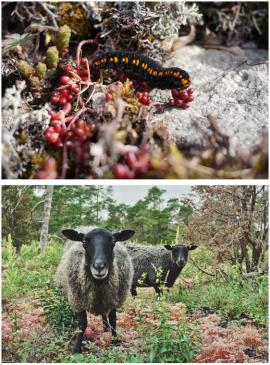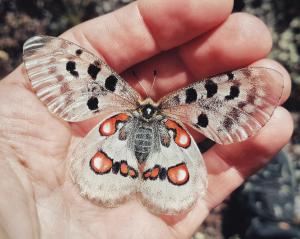Discussion
Larvae & vegetation mapping

The results on larval occurrence showed that there where many different variables that significantly impacted the variation. In turn, this represents a need for habitat heterogeneity as it provides to the thermoregulatory needs of the larvae. E.g. in field, larvae were seen seemingly using fruticose lichens to thermoregulate depending on the weather conditions. This is further supported by other studies who have proposed that larvae utilises variation in vegetation to thermoregulate.
Another important finding that the results illustrate is the importance in measuring a variable on different scales. This is displayed by the two different measures of bushes, where increased mean bush hight decreased larval occurrence whilst increased bush cover instead increased larval occurrence. I.e. larvae prefers areas with high bush cover but the bushes should not be too high.
Further, it is clear that the current grazing density within the study site has a negative impact on larval density. Previous studies have discussed that grazing may cause trampling of larvae as well as a loss of nectar resources for adult butterflies. As grazing is a tool in preserving semi-natural grasslands, by preventing them from over-growing, this study shows that it is important to find threshold values for what grazing density the Apollo butterfly can manage. Also, alternative methods in keeping openness should be considered such as manual mowing.

Capture-mark-recapture
Sex ratios was skewed in the present study and strongly biased towards males. However, this is explained by the more cryptic behaviour of females who are often observed sitting whilst males are seen more active in flying, thus being more detectible.
The estimated population size of 17063 individuals in Filehajdar is a rough estimate and should be considered with some caution. However, despite this, it still demonstrates that the Apollo butterfly population size on Gotland is unique in its size. Previous studies from around Europe has reported on estimated population sizes from a few hundred to the low-thousands.
Regarding the habitat preferences of the adult butterflies, only two variables made it into the final model displaying their preference for open areas and high abundance of nectar plants. The lack of significant results regarding the environmental variables and their impact on adult butterfly densities can be explained by the fact that adult butterflies are able to move across much larger areas compared to the larvae. The Apollo butterfly is a large butterfly with an ability fly long distances. Thus, it is not confined to nor dependent on the habitat quality of individual patches to the same extent as the larvae. This is further supported by previous studies, reporting that patch size and connectivity are highly important to the adult butterfly.
Nectar resource mapping

Adult butterflies did not show a significant preference in their choice of nectar plant species on a 0.05 level. However, it was significant on a 0.1 level, indicating that there might be a trend towards selective choice of nectar plant species. Regarding the colour of nectar plant flowers, the results were significant on a 0.05 level. This combined indicate that it is the properties of the nectar plant, such as colour, more so than the specific plant species that influences the butterfly’s choice of nectar plant.
As this study only assessed the colour of flowers, it is important to point out that there might be additional factors that influences the choice of nectar plants. E.g. studies have reported on differences between the sexes, where female butterflies prefer flowers on short stems compared to males who prefer flowers on long stems.
Further, there are many improvements to be made to the current method used in the nectar resource mapping. The chosen sampling method only managed to pick up a total of 4.5m2 of each one-hectare grid cell. Consequently, most of the total area was left un-surveyed. Also, as the circular plots were distributed at a 25m distance from each other, hence, plants that grows aggregated on smaller patches was not recorded in an equal matter to plants that grow more evenly distributed over larger areas.
Responsible for this page:
Director of undergraduate studies Biology
Last updated:
05/17/21
